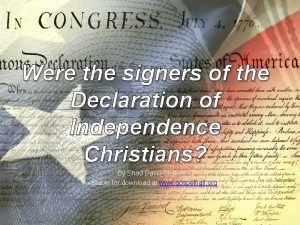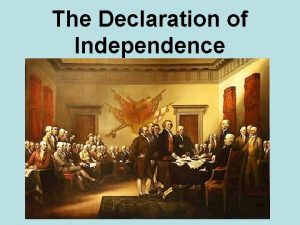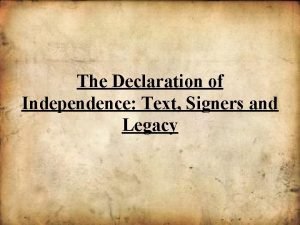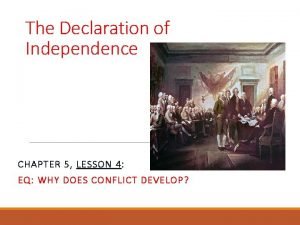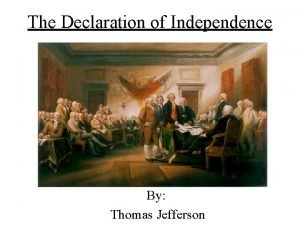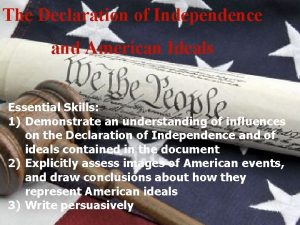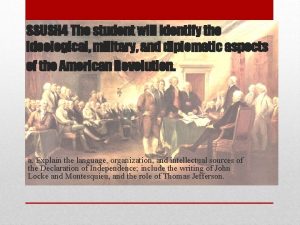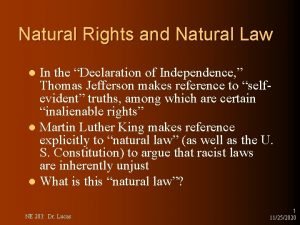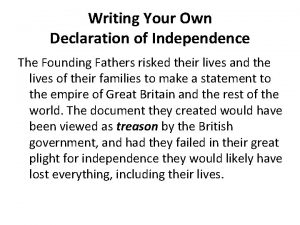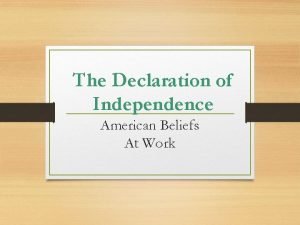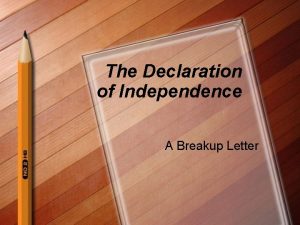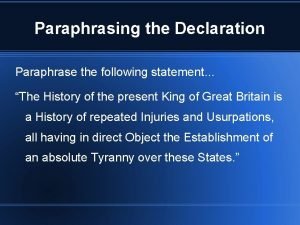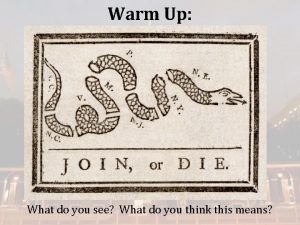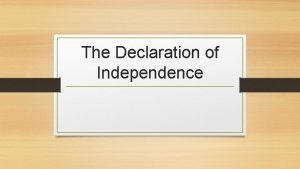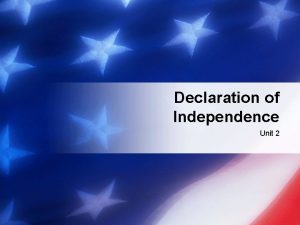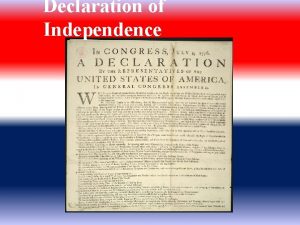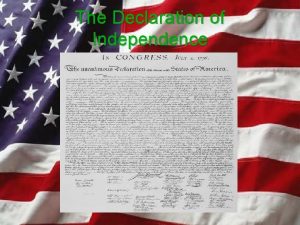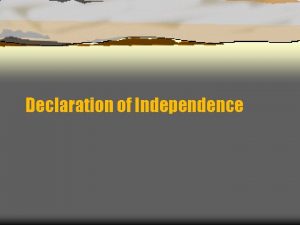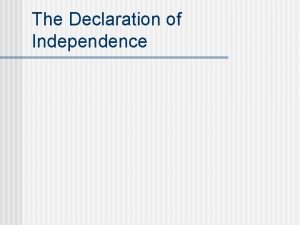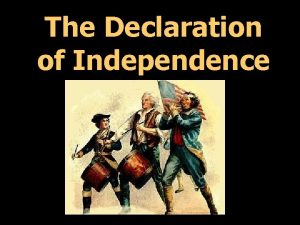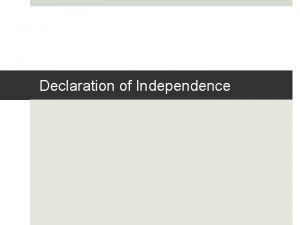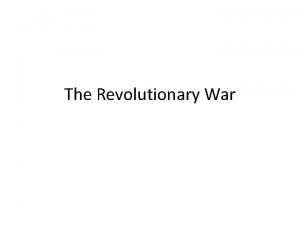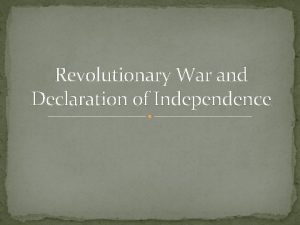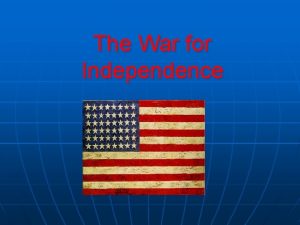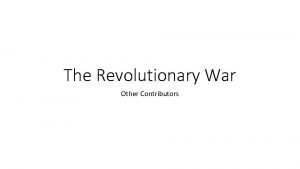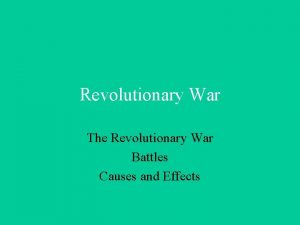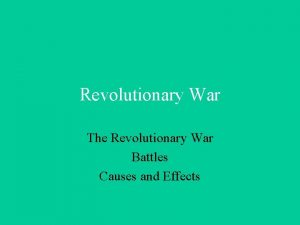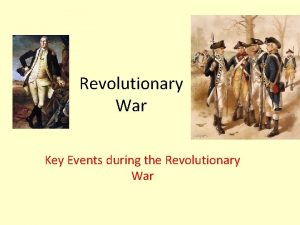Unit Five The Revolutionary War Declaration of Independence


















- Slides: 18

Unit Five: The Revolutionary War Declaration of Independence

Independence • During the early part of the Revolutionary War with the British retreat from Boston and the failed invasion of Canada, the colonists were looking toward either surrendering or going all out and declaring war; no more Half-War. • In the early part of 1776 Thomas Paine’s Common Sense was published and widely distributed, causing many colonists to call for full Independence. • The Prohibitory Act of 1775 came into full affect with a complete Naval blockade of American ports and making American merchant vessels, enemy vessels on the high seas.

Independence • In the early months of 1776 each colonial government was debating the issue of a formal declaration of independence. • In the Second Continental Congress (S. C. C. ) John Adams wrote a Preamble or explanation as to why the Colonies “needed” to declare Independence. • In May Richard Henry Lee with backing from the Virginia Convention made the motion for a formal Declaration of Independence to be written and sent to the King.

The Declaration of Independence • The advantages (Incentive for war, allow foreign help, and creation of own nation) and disadvantages (patriots hung for treason, little to no trade with British, and no more British aid) were weighed. • The S. C. C. appointed a Committee of Five (John Adams, Benjamin Franklin, Roger Sherman, Robert Livingston, and Thomas Jefferson) to draft a resolution of Independence. • Thomas Jefferson wrote most of the document that is why he is called the Father of the Declaration of Independence.

The Declaration of Independence • The Declaration was made up of three parts: Preamble, List of Complaints, and Formal Resolution of Independence. • The Preamble set forth grand ideas of the right of revolution, natural rights, equality of man, civil liberties, and democratic governance. • Jefferson was inspired by the ancient Greeks and Enlightenment ideals, especially the writings of John Locke.

Preamble • The Preamble’s key ideals: – Natural Rights- rights people are given because they are humans. – Inalienable Rights- rights that can not be taken away by the government. – Democracy- the belief that power for government comes from the people. – Republicanism – The head of a state and government officials are elected by the people. – Liberalism – the belief in the importance of liberty and equality

The Declaration of Independence • “We hold these truths to be selfevident, that all men are created equal, that they are endowed by their Creator with certain unalienable Rights, that among these are Life, Liberty and the pursuit of Happiness. ”

The Declaration of Independence • The Declaration of Independence was approved and signed on July 4, 1776, Independence Day. • On July 8, 1776 supposable the Liberty Bell was rang to summon people to hear their declaration of Independence. • Proclaim LIBERTY throughout all the Land unto all the Inhabitants thereof Lev. XXV X – Inscription on bell.

A Symbol of Hope • Betsy Ross is given credit (even though false) for the creation of the first American flag commissioned by George Washington. • This was not the only flag but one of many flown by each colony, militia, and vigilante group.

Issues with War • One of the most important issues dealing with the war was funding which was taken care of by Robert Morris and Haym Solomon who financed a lot of the war effort. • The next was foreign help which led to the sending of ambassadors to Spain (Arthur Lee) and France (Benjamin Franklin) to try to get them to give assistance of any kind. • The last was popular support, which gradually as the war went on drifted in favor of the war.

The British are Back • In Canada General Howe formulated a plan to regain a foothold in America through New York City. • Out of fear of losing New York, Washington was sent to fortify New York City from attack. • Washington concentrated his fortifications on Manhattan and Long Island, but because of the amount of water and area it was too hard to defend.

The British are Back • General Howe with the aid of his brother Richard “Lord” Howe (admiral of the navy) came to New York with 32, 000 men with 400 ships setting up a base on Staten Island. • In the Battle of Long Island the British outflanked the Patriots and forced them to retreat to their fortifications on Brooklyn Heights, then across the East River to Manhattan. • Washington then fortified the Harlem Heights and attempted to sink Howe’s flagship the HMS Eagle with a submarine called the Turtle, then waited to see what the British would do.

The British are Back • In the Battle of Manhattan Howe quickly forced Washington to retreat across the Hudson into New Jersey. • General Howe sent General Lord Cornwallis to capture Washington, but he was able to cross the Delaware River into Pennsylvania before being captured. • Out of fear of Philadelphia being taken the S. C. C. moved to Baltimore, Maryland left Washington in complete control of the army.


Dark Days • During the winter months of 1776 the battle front looked bad for the Patriots and morale was very low. • During this time Thomas Paine wrote the Pamphlet The American Crisis talking about bandwagon patriots he called Sunshine Patriots stating that “these are the times that try men’s souls. ” • While encamped across the Delaware Washington knew something had to be done to boost morale are all was lost.

Battle of Trenton • Washington’s plan was to cross the Delaware River and march on the town of Trenton on Christmas night and attack a regiment of Hessians at daybreak. • The Battle of Trenton was a complete success with the surrender of the Hessian General Mercer without one Patriot’s life lost. Emanuel Leutze 1851

Battle of Princeton • Washington quickly took the offensive success and marched on Princeton where the British were encamped. • At the Battle of Princeton Washington outflanked Cornwallis attacking his rearguard forcing Cornwallis to retreat back to New York. • Washington was able to rally his fleeing men by riding his horse in between both lines.

Retiring for Winter • After the Battles of Trenton and Princeton, Washington encamped his men for winter at Morristown only 30 miles away from New York. • This allowed Washington to use spies to keep a close eye on General Howe. • The close of 1776 saw a huge morale booster for the cause, but as many knew the war was not over and the darkest hour had not yet happened.
 What does the declaration of independence say
What does the declaration of independence say Grievances in the declaration of independence
Grievances in the declaration of independence Declaration of independence sections
Declaration of independence sections Declaration of independence sections
Declaration of independence sections Lesson 4 declaring independence
Lesson 4 declaring independence Declaration of independence all men are created equal
Declaration of independence all men are created equal Ideals in the declaration of independence
Ideals in the declaration of independence Montesquieu declaration of independence
Montesquieu declaration of independence Natural rights
Natural rights Thomas hobbes declaration of independence
Thomas hobbes declaration of independence Write your own declaration of independence
Write your own declaration of independence Grievances in the declaration of independence
Grievances in the declaration of independence Break up letter declaration of independence
Break up letter declaration of independence Teenage declaration of independence
Teenage declaration of independence Paraphrase the declaration of independence
Paraphrase the declaration of independence Declaration of independence dbq
Declaration of independence dbq Summary of declaration of independence
Summary of declaration of independence Too late to apologize a declaration meaning
Too late to apologize a declaration meaning Who wrote the declaration of independenc
Who wrote the declaration of independenc
